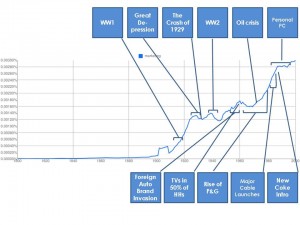history of marketing, part two
Last week I started a recap of the History of Marketing, which was actually inspired by the future – that is, the comments I got about my write-up on the Future of Marketing micro-conference in which marketing experts like Guy Kawasaki, Scott Monty, and Frank Gruber shared what they expect the future of marketing will bring.
The source for my analysis of the History of Marketing is a Google Labs N-gram Viewer which shows the frequency with which “marketing” appeared in English books between 1800-2000. My last post left off in the early 90’s when case-study and principle-laden texts like The 22 Immutable Laws of Marketing and Managing Brand Equity were published.
Now to the recent past:
Beginning at the turn of the millennium, books about marketing took a more of a philosophical, idea-inspired tact.
Seth Godin’s Permission Marketing: Turning Strangers into Friends, and Friends into Customers, published in 1999, is a good example. In it, Godin contrasts “interruption marketing” with a new idea, “permission marketing.” That is, if you want to grab someone’s attention, you first need to get his or her permission with some kind of bait.
Come to think of it, the anthology of books Godin released at an annual clip throughout the past decade provide a good summary of what marketing has become:
- Unleashing the Ideavirus (2001) challenged readers to “stop marketing AT people! Turn your ideas into epidemics by helping your customers do the marketing for you.”
- The Big Red Fez: How To Make Any Web Site Better (2002) provided a practical guide to making websites more attractive to browsers.
- Survival Is Not Enough: Why Smart Companies Abandon Worry and Embrace Change (2002) encouraged readers to teach their companies to “zoom” – that is, embrace change without pain.
- Purple Cow: Transform Your Business by Being Remarkable (2003) suggested that marketers should create products and services that are worth marketing in the first place.
- Free Prize Inside!: The Next Big Marketing Idea (2004) explained the way to make any product a bestseller is to couple it with “a feature that the consumer might be attracted to” whether or not she really needs it or wants it.
- All Marketers Are Liars: The Power of Telling Authentic Stories in a Low-Trust World (2005) clarified that great marketers don’t talk about features or even benefits. Instead, they tell a story.
- Small Is the New Big and 193 Other Riffs, Rants, and Remarkable Business Ideas (2006) included ideas like the “first key to successful marketing is to produce something remarkable and let it grow.”
- The Dip: A Little Book That Teaches You When to Quit (and When to Stick) (2007) was about “the Dip” — “the long slog between starting and mastery” in which those without the determination or will find themselves burning out.
- Meatball Sundae: Is Your Marketing Out of Sync? (2008) explained that New Marketing treats every aspect of interacting with customers—including customer service and the product itself—as an opportunity to grow the organization.
- Tribes: We Need You to Lead Us (2008) introduced the idea that lasting and substantive change can be best effected by a tribe: a group of people connected to each other, to a leader and to an idea.
- Linchpin: Are You Indispensable? (2010) exhorted readers to be people who invent, lead (regardless of title), connect others, make things happen, and create order out of chaos.
- And finally Godin’s upcoming release Poke the Box (2011) is supposed to be a call to action to take initiative.
I don’t intend the above to suggest that the only meaningful books of the recent past have been written by Godin, nor that he speaks, er…writes, for all — but I do think this compilation reflects the marketing of recent history — it’s all about new: new ways to engage with customers/people in general, new tools, and new approaches to thinking about and doing business.
History of Marketing Observations
This analysis of the History of Marketing raises several points for me:
A lot has changed, but some things never do. We continue to struggle with how to define marketing and how to do it.
The trajectory of marketing reflects broader business, economic, and cultural trends. At the dawn of the last century, the shift to an industrial age produced new business challenges to which marketing was applied. At the turn of this century, innovation, relationships, and values have risen as top issues for almost all organizations – and marketing has evolved to address these.
Marketing is a popular topic. Once it surfaced as a concept in books, it was mentioned at levels comparable to God:
related posts:
- history of marketing, part one
- future of marketing
- insights and soundbites from seth godin

